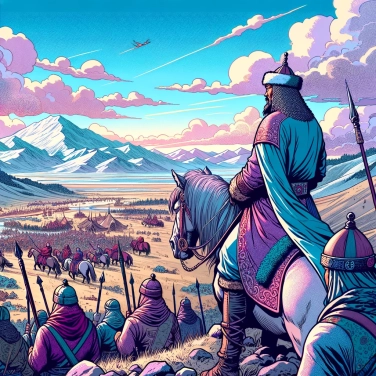Genghis Khan conquered such a vast territory by implementing innovative military tactics, exploiting divisions among the conquered peoples, and establishing an efficient administrative system to control and govern the Mongol Empire.

Genghis Khan was an extraordinary leader due to his powerful charisma and his ability to inspire unwavering loyalty in his warriors. He knew how to identify the strengths and weaknesses of each individual, cleverly placing his best generals in the right positions. His relentless will pushed his men to go beyond their limits, and he generously rewarded those who proved themselves. He also advocated for an unusual meritocracy for the time, where key positions did not necessarily go to nobles but to the most talented and competent, regardless of their background. This approach ensured him warriors who were not only effective but also wholly devoted to his cause.
Mongol warriors were able to move ultra-fast with their robust and swift horses. This allowed them to execute highly effective lightning attacks against often overwhelmed enemies. They skillfully employed mounted archery, shooting deadly arrows while remaining in motion, making their strength difficult to counter. Their tactics often relied on feigned retreats: they would simulate a withdrawal, lead their opponents into a trap, and then suddenly return to attack by surprise. Add to that their incredible ability to coordinate different distant military units through a signaling system (flags or smoke), and you better understand how they dominated the battlefield. Especially since they constantly adapted their strategy to the situations they encountered, without sticking to a single model.
The Mongols were champions at quickly assimilating the military methods and innovations of the peoples they faced or interacted with. For example, they had a perfect mastery of the use of composite bows, those short, very powerful bows that were easy to handle from a galloping horse. Their mastery of mounted archery was like having an army of surprise snipers at all times, which seriously disrupted the enemy. They also rapidly adopted siege techniques such as Chinese catapults or the military engineering methods of the Central Asian peoples. Another simple and effective innovation was their communication system through relay messengers (yam), allowing them to transmit information quickly over thousands of kilometers. All of this, combined with a great tactical flexibility, allowed the Mongols to be remarkably responsive in countering their adversaries.
The Mongols are organized into clear groups: units of 10 warriors called arban, grouped by tens and hundreds, forming thousands fighting together (tumen). This allows them to be truly responsive and effective on the battlefield. Each warrior follows precise and strict rules, such as never leaving their unit without permission under the threat of severe penalties. They all feel invested in their task and responsible for one another. This creates incredible discipline: there is no room for hesitation or disorder in battle. Because of this, Genghis Khan always knows exactly how his men will react, whether to attack quickly or to retreat in good order. This rigorous discipline combined with unwavering solidarity gives the Mongol army a formidable effectiveness against their adversaries, even those outnumbering them.
Genghis Khan mastered the art of using local rivalries to his advantage. Instead of attacking all his enemies at once, he identified regional tensions, temporarily allied with some to more easily crush others. For example, with the Uyghurs, a powerful ethnic group in Central Asia, he skillfully negotiated a partnership that gave him access to skilled merchants, scribes, and diplomats. In this way, he was able to conserve his military resources and strengthen his own strategic position. Similarly, by exploiting internal disputes or jealousies among certain kingdoms, such as the Khwarezmian Empire, he faced fewer direct opponents to fight simultaneously. In short, Genghis Khan observed, negotiated, and divided to better rule.
Did you know that the Mongol Empire, under Genghis Khan, used a relay communication system (the Yam), similar to the modern postal system, allowing them to cover up to 200 kilometers per day?
Unlike many military leaders of his time, Genghis Khan judged his officers based on their merit rather than their social or family background, a tactic that allowed him to obtain the best talents and strengthen his army.
Despite his bloodthirsty reputation, Genghis Khan practiced a remarkable form of religious tolerance for his time, allowing for peaceful coexistence among various religions within his empire.
The Mongol riders under Genghis Khan could remain in the saddle for several days continuously, using unique techniques that even allowed them to sleep while riding their horses!
Absolutely. The Mongol conquests profoundly influenced trade and cultural relations between Europe, the Middle East, and Asia. They facilitated the spread of ideas, technologies, and know-how. Furthermore, the opening of trade routes such as the Silk Road allowed for an unprecedented cultural exchange.
The Mongols were highly skilled in light cavalry and relied on their unique ability to quickly change mounts to cover great distances. They carried little heavy equipment, used a diet suited to nomadism, and each soldier owned several horses to avoid exhausting their mounts.
Among the major civilizations conquered were the Khwarezmian Empire in Persia and Central Asia, the Jin dynasty in Northern China, as well as various nomadic peoples of the Eurasian steppes, which allowed the Mongols to significantly expand their territory.
In addition to being a relentless military leader, Genghis Khan was also an administrative and political visionary. He introduced the Mongolian script, established a legal code called Yassa, and encouraged religious tolerance as well as trade and cultural exchanges, fostering unity and stability within his vast empire.
At its height, the Mongol Empire, established by Genghis Khan, covered nearly 24 million square kilometers, or about a quarter of the Earth's surface known at the time, stretching from Eastern Europe to the Sea of Japan.

No one has answered this quiz yet, be the first!' :-)
Question 1/5